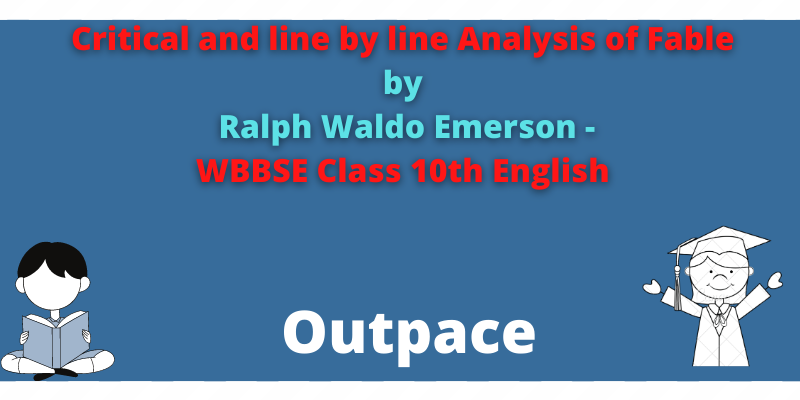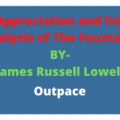About the Poet:

Ralph Emerson was a popular American writer, poet and a philosopher as well during the nineteenth century. The poet was conceived in Boston, Massachusetts on 25th May 1803. He was mostly raised by his mom. The poet started composing verse in the wake of moving to St. Augustine in Florida. He went to the Boston Latin School and later moved on from a Harvard University in 1821. In 1826, he got a license to be the priest and joined as one in the Unitarian Church in 1829. He began accepting the convictions and thoughts of transcendentalism in 1832.
He gave heaps of talks on subjects identified with the theory of history in Boston. The principal paper distributed was “Nature”. Emerson distributed his second book in the year 1841 that was named “Articles”. This book incorporated his renowned paper “Independence”. He was considered as one of the most “liberal- democratic” masterminds of his time. A portion of his exceptionally unmistakable distributions incorporates “Essays: First Series” (1841), “Essays: Second Series” (1844), “Poems” (1847), “The Conduct of Life” (1860), and so on. He additionally composed poems like “Fable”, “Uriel”, “Brahma” and essays like “Politics”, “The Poet”, “New England Reformers” and the rundown goes on.
Emerson died in 1882 on April 27 at 78 years old years in Concord, Massachusetts.
About the Poem:
The poem “Fable” written by Ralph Emerson is an example of a short poem with a great message that is being portrayed in a very simple manner. The poem has very elegantly sent an important message. Every creation of nature has a significant role to play, the poem starts with an argument between the mountain and a squirrel about the importance of the squirrel in nature. The poem explains how one should never undervalue oneself. One should also, never look down upon someone else.
Every individual has their own importance and without them, there might be an imbalance in the whole system.
“All is well and wisely put”
This explains how every individual and every other creation of nature is useful and nothing is pointless. All of us have been created for some purpose. We have been made in such a way that we are interdependent on each other; we cannot survive completely on our own. Talents always differ. Everybody is good at something or the other and should never be judged only based on their shortcomings. Most of the content is comprised of the squirrel doing what it can to persuade the mountain it is deserving of living there, despite the fact that it is smaller.
Structure of the Poem:
Fable
“The mountain and the squirrel Had a quarrel; And the former called the latter ‘Little Prig.’ Bun replied, ‘You are doubtless very big; But all sorts of things and weather Must be taken in together, To make up a year And a sphere. And I think it no disgrace To occupy my place. If I'm not so large as you, You are not so small as I, And not half so spry. I'll not deny you make A very pretty squirrel track; Talents differ; all is well and wisely put; If I cannot carry forests on my back, Neither can you crack a nut.’”
The poem “Fable” has 19 lines and has a rhyming scheme of “AABCBDDEEFFGHHIJKJK”. It is clear that not all of the lines of the poem rhyme with each other, also there is no consistent rhyming pattern. This is Emerson’s approach to put significance on a line and change the rhyme in order to change the feeling. The title of the poem does justice to the content of the poem. A fable is an idyllic story created in verse or prose with a good summarized toward the end. Normally animals are utilized as characters to portray a significant message. In this poem, a squirrel and an inanimate object (mountain) have been used to explain the lesson.
Line by Line Analysis of the Poem:
Lines 1-3:
“The mountain and the squirrel Had a quarrel; And the former called the latter ‘Little Prig.’”
The speaker starts by expressing the primary content of the piece in the very first stanza. There is a mountain and a squirrel and they got into a battle or something to that effect. A reader ought to quickly see that Emerson utilized the world “quarrel” to depict the casual fight. This makes it appear to be less genuine and serious at that point. It is a brief vexed to their typically even relationship. Both of these characters have been vigorously personified, to such an extent they can address each other and decipher unwanted activities. The decision to organize the lines as such and amaze the reader with the hard “g” consonant gives further accentuation to the insult.
Lines 4-9:
“Bun replied, ‘You are doubtless very big; But all sorts of things and weather Must be taken in together, To make up a year And a sphere.”
In the fourth line, the speaker addresses the squirrel as “Bun”. It is answering to the mountain in an exceptionally clear and articulate manner. He chooses his words cautiously. The squirrel begins by recognizing that the mountain is “very big”. It has a reality the squirrel can’t deny. The squirrel is endeavouring to make peace and deal with the way that they won’t generally get along. One can’t like to live in harmony with each kind of being, conscious or not.
These articles, animals, and individuals all “make up a year/And a sphere.” The world is developed of the great and the awful, both are similarly vital for life to go on.
Lines 10-14:
“And I think it no disgrace To occupy my place. If I'm not so large as you, You are not so small as I, And not half so spry.”
- Oxymetholone 25 mg Elbrus Pharmaceuticals: Efectividad y Opiniones de los Usuarios
- $1000 Deposit Reward
- On-line Casino Canada $1000 Pleasant Added Bonus + 10 Daily Spins
- Spin Casino Nz Review $1 Downpayment Delightful Added Bonus
- çevrimiçi casino incelemeleri
In the above lines, the squirrel spreads out his contention. The premise of the fight is additionally uncovered here. He doesn’t see anything amiss with his possession of one “place” on the mountain. Similarly, as the mountain is huge, with an enormous task to carry out, the squirrel is little with an equivalent task to carry out. Both must exist at a time. So as to deal with the mountain the squirrel spreads out their individual favourable circumstances and burdens. Initially, the mountain is a lot bigger than he is—something he acknowledges as reality. Yet, the squirrel is considerably more “spry”.
Lines 15-19:
“I'll not deny you make A very pretty squirrel track; Talents differ; all is well and wisely put; If I cannot carry forests on my back, Neither can you crack a nut.’”
He proceeds on a similar track in the following arrangement of lines. The squirrel is endeavouring to assuage the mountain while likewise indicating his own advantages. They are rises to on the planet if not in size, speed and capacities.
First, he praises the mountain. This is another marginally underhanded compliment as the mountain is supposed to be a “pretty squirrel track.” The mountain is delightful and an ideal spot for a squirrel to meander. He concedes their gifts are extraordinary. The mountain can convey woodlands on its back yet it can’t “crack a nut.” There is something about its powerlessness to finish such a basic assignment, that loans the completion of the sonnet a not exactly sympathetic tone. It is clear the squirrel despite everything holds resentment against the mountain for its endeavour to drive the squirrel from its back.
Figures of Speech Used in the Poem:
Personification
- Personification is a figure of speech in which animals or other inanimate objects are credited with human feelings, emotions and abilities.
The whole poem has been personified in away. Animals (squirrel) and inanimate objects (mountains) have been personified in order to display the main content of the poem. The whole poem is a dialogue between the mountain and the squirrel.
Litotes
- It is a figure of speech where the affirmative is articulated by negating its contrary.
- “And I think it no disgrace”.
- “If I’m not so large as you”.
- “You are not so small as I”.
Important Word Meanings
- Spry: Agile.
- Squirrel track: Symbolism for resourcefulness.
The Theme of the Poem
The primary theme of the poem is to accept one’s shortcomings and not judge anybody else. One should know that every individual has a role to play in nature. It is necessary to follow this to have a healthy mindset in today’s date. Everybody should be happy with what gifts they received with and embrace their flaws (just like the little squirrel in the poem).
The poem has very simply expressed the importance of self-love and how we should never look down upon someone else.





